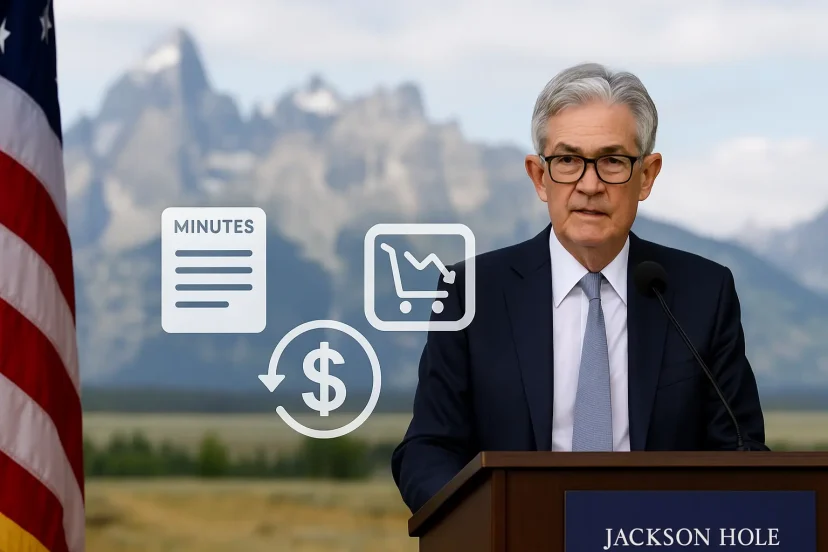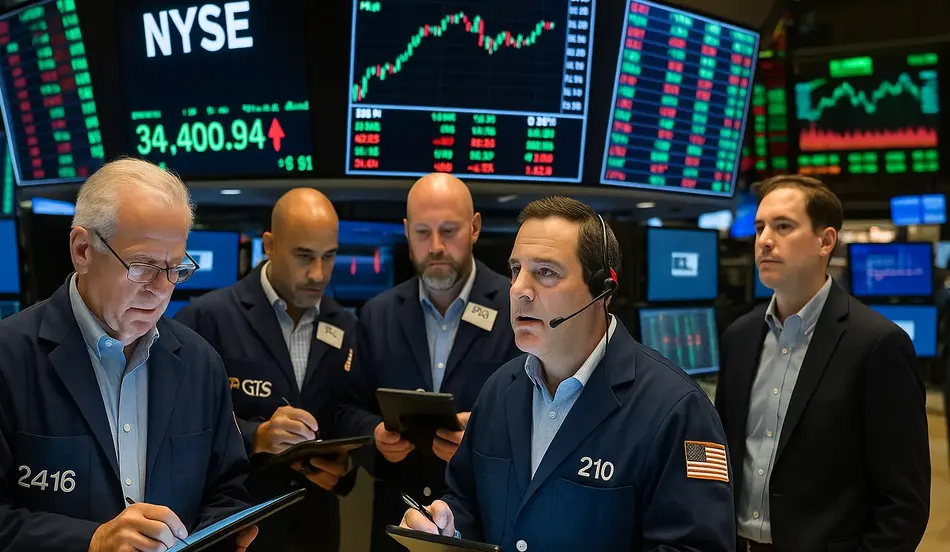The Jackson Hole Powell Speech 2025 is set to be a defining moment for U.S. markets, with investors, businesses, and policymakers closely watching a trio of critical developments: the Federal Reserve’s July meeting minutes, retail earnings reports, and Powell’s keynote address at the annual Jackson Hole Economic Symposium.
Together, these events will offer a window into the health of the U.S. economy, the trajectory of consumer spending, and the Federal Reserve’s readiness to cut interest rates as the labor market softens.
For employers and job seekers alike, the implications are significant: retail earnings reveal the strength of household budgets, while Powell’s tone may determine whether September brings relief in the form of lower borrowing costs—or more uncertainty.

Fed Minutes and Jackson Hole Powell Speech 2025: A Roadmap to Policy Thinking
The release of the Federal Reserve’s July meeting minutes is the first key moment of the week. Markets are searching for clues on just how concerned central bankers are about:
- Cooling inflation: Core personal consumption expenditures (PCE)—the Fed’s preferred measure—has moderated.
- Softening labor demand: Job gains have slowed sharply to an average of just 35,000 per month this summer, far below pre-pandemic norms.
- Weaker consumer sentiment: Surveys show Americans growing cautious, particularly around big-ticket purchases like cars and appliances.
Investors hope the minutes will reveal whether Fed officials believe inflation is low enough—and job growth weak enough—to justify a rate cut in September.
Economists note that a cut is not simply about Wall Street—it directly affects credit card rates, mortgages, and small-business loans, all of which shape hiring and investment decisions.
Retail Earnings in the Spotlight
Perhaps the most direct barometer of economic strength this week will come from earnings reports by major retailers:
- Target will report sales and margins closely watched for insights into middle-income household spending.
- Lowe’s earnings will provide a snapshot of home improvement demand, a sector tied to housing affordability and mortgage rates.
- TJX Companies (parent of TJ Maxx, Marshalls, and HomeGoods) are expected to highlight bargain-hunting trends, reflecting how households adjust when budgets tighten.
Why Retail Earnings Matter
Retail accounts for nearly 70% of U.S. GDP through consumer spending. If sales are robust, it signals resilience. But if they falter, it may suggest that higher prices and cautious employers are constraining disposable income.
Already, retailers have reported rising inventory costs, as businesses struggle with supply chain disruptions and tariff-related expenses. These pressures, combined with flat wage growth, could spell leaner months ahead.
Powell’s Jackson Hole Speech: A Global Stage
Every August, central bankers, finance ministers, and economists gather in Jackson Hole, Wyoming. This year, Powell’s speech is being viewed as the single most important economic event of the summer.
Why? Because the markets are betting on it. Futures trading suggests an 85% chance of a September rate cut. Investors want clarity: Will the Fed deliver?
The Stakes for Powell
Powell must walk a fine line:
- If he signals a strong commitment to rate cuts, markets may rally, but inflation fears could resurface.
- If he takes a cautious stance, emphasizing patience, markets could react negatively, interpreting it as a lack of urgency.
- If he surprises with hawkish remarks, he risks tightening financial conditions at a fragile moment.
Historically, Jackson Hole has been the venue for major policy signals. Former Fed chairs Ben Bernanke and Janet Yellen used it to announce shifts in monetary direction. Powell’s remarks this week will likely be dissected word-for-word.
Hire Strategically as Markets Shift
Post your job on WhatJobs and secure top talent—position your business for growth no matter how the Fed’s next move impacts the economy.
Post a Job Now →Labor Market Implications
For American workers, the connection between Powell’s speech and retail earnings may seem distant. But together, they shape the environment in which hiring decisions are made.
- Employers remain cautious: Companies are reluctant to expand payrolls amid uncertainty around tariffs, inflation, and demand.
- Workers face stagnant wages: Even as layoffs remain historically low, job openings have slipped to 7.4 million in June, the lowest in over three years.
- Young workers struggle: Entry-level hiring is soft, particularly in white-collar sectors where AI and automation pressures loom.
If Powell confirms a September rate cut, it could reduce financing costs for businesses, potentially encouraging new hiring. But if inflation surprises persist, rate relief may be delayed, prolonging hesitation in the job market.
Markets and Employment: A Feedback Loop
Financial markets and the labor market are more interconnected than they appear:
- When stocks rise, corporate confidence often improves, leading to new investments and job creation.
- When borrowing costs fall, small businesses are more likely to expand staff.
- When consumer confidence rises, households spend more, boosting demand for retail, hospitality, and services.
Thus, the Fed’s decisions—and Powell’s words—can ripple from Wall Street to Main Street in weeks.
Inflation Concerns Cloud the Outlook
One complicating factor is the Producer Price Index (PPI), which jumped 0.9% in July, well above expectations. If businesses pass on those costs, consumer inflation could re-accelerate.
That dynamic poses a dilemma: the Fed wants to support hiring with lower rates, but it must avoid reigniting inflation. For workers, that means uncertainty: cheaper credit could be delayed if inflation proves sticky.
Global Attention on Jackson Hole
It isn’t just American markets watching Powell. Global investors, from Tokyo to Frankfurt, are paying attention. U.S. monetary policy sets the tone for global capital flows.
- Stronger dollar risk: If the Fed holds back on cuts, the dollar may strengthen, hurting exporters.
- Global hiring: Emerging markets could see tighter credit if U.S. rates remain high.
- Investment flows: International companies may adjust hiring in the U.S. based on Powell’s stance.
The Jackson Hole symposium is as much a diplomatic moment as it is a policy event.
FAQ: Fed Minutes, Retail Earnings, and Jackson Hole
Q1: Why are the Fed’s July minutes so important?
They provide detailed insight into how policymakers are thinking about inflation, jobs, and rates. Markets look for clues about the likelihood of near-term cuts.
Q2: How do retail earnings affect the broader economy?
Retail earnings reflect consumer spending trends, which drive nearly 70% of U.S. GDP. Weak retail numbers may signal household strain and potential job losses.
Q3: Why is Powell’s Jackson Hole speech such a big deal?
Jackson Hole has historically been a stage for major policy shifts. Powell’s words can sway global markets and signal the Fed’s next move.
Q4: How could a September rate cut affect workers?
Lower rates reduce borrowing costs for businesses, making it cheaper to invest and hire. Workers may see more job opportunities if cuts materialize.
Conclusion
This week’s convergence of Fed minutes, retail earnings, and Powell’s Jackson Hole speech represents more than just a flurry of headlines—it is a test of the U.S. economy’s direction.
For markets, clarity on interest rates could unlock a rally or deepen uncertainty. For retailers, earnings will reveal whether American households still have spending power. And for workers, the Fed’s next move could determine whether hiring revives—or remains stuck in a cautious holding pattern.
As Powell prepares to take the stage in Wyoming, investors, businesses, and job seekers alike are asking the same question: Is relief finally on the way, or is uncertainty here to stay?




